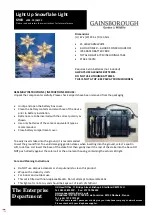
Microbiological Space
Decontamination
Clean Exterior
Surfaces
Clean Window
5-4 1500 Series A2
Thermo Scientific
Section 5
Cleaning and Decontamination
NSF/ANSI 49, Annex G recommends a microbiological space
decontamination when maintenance work, filter changes, and performance
tests require access to any contaminated portion of the cabinet and before
the BSC is moved to another location. A microbiological space
decontamination may also be required by the BSC owner or user before
certification or as a part of their work procedures. NSF/ANSI 49 provides
recommended procedures for microbiological space decontamination using
formaldehyde and chlorine dioxide. NSF/ANSI 49 also recognizes that
alternative methods including the use of vaporized hydrogen peroxide are
sometimes validated and approved by BSC owners and users. The
appropriate method and procedure should be reviewed and approved by
interested parties including the BSC user, institution biological safety
officer, and BSC certification and service personnel as appropriate.
Warning
Decontamination with formaldehyde and chlorine dioxide must
be performed in accordance with the specifications of NSF/ANSI 49,
Annex G. As this procedure has considerable risks, it must only be
performed by specially trained and authorized service personnel! Before
Decontamination with chlorine dioxide, the BSC must be sealed at the
exhaust opening and front opening to eliminate exposure to chlorine
dioxide, of the power supplies, PCBs and other components under the
front canopy as
they are susceptible to damage from the process
.
s
Thermo Fisher Scientific has developed validated procedures for the
decontamination of the Thermo Scientific 1500 Series A2 using the Steris
VHP (Vaporized Hydrogen Peroxide) system. These procedures are
available on request.
Clean the exterior surfaces of the cabinet using a solution of tepid water
and commercially available mild dishwashing agent. Then, dry all surfaces
well, using a soft, clean cloth.
For cleaning, the window can be lowered beyond the closing position (Use
of the Window, Section 1).
Creating a gap at the window’s upper edge ensures that the upper portion
of the window can be cleaned and/or disinfected. Use a commercially
available window cleaner to clean the window.
















































